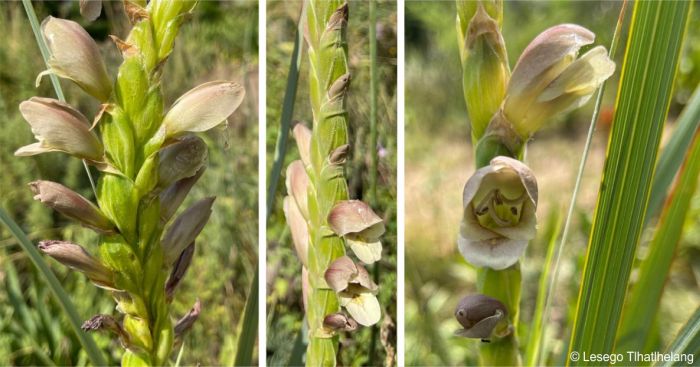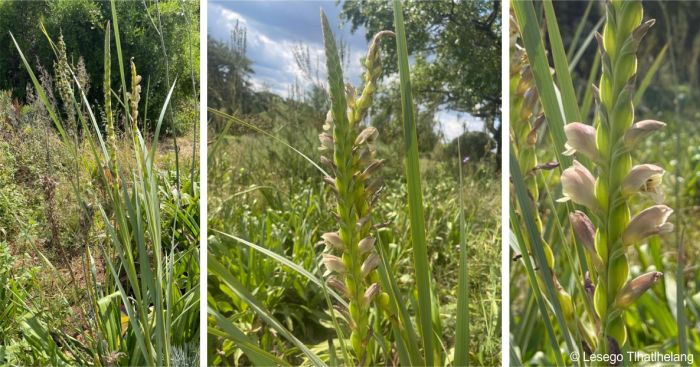Gladiolus sericeovillosus
Gladiolus sericeovillosus Hook.f.
Family: Iridaceae
Common names: large speckled gladiolus (Eng.); isidwa, udwendweni, isidwa esincane, umlunge (siZulu); bloupypie (Afr.); sidvwana (isiSwazi)
Introduction
Gladiolus sericeovillosus is a medium-sized, summer-flowering Gladiolus with flower spikes up to 1.5 m tall with dull red, lilac, pink, white or cream spotted flowers in late summer and autumn and grows in grassland in the summer-rainfall regions of southern Africa.

Description
Description
Plants are between 0.35-2 m high, they can grow to be quite tall. Leaves are green with orange margins and they can grow to the height of 2 m. A plant produces 5 to 7 leaves, with the bottom 4 to 5 being basal, sometimes exceeding the spike by twice as much. Stems are straight, erect, occasionally branching, hairy or smooth, 4-6 mm in diameter just below the spike. Bracts are pale green and soft, typically dry and pale in the upper 5 mm. Flowers have coloured tepals with dark red-maroon points, often concentrated in the midline of the lower tepals, and can be greenish to cream, pink, pale lilac, or dull red, sometimes speckled with red or maroon. Flowers are distichous, meaning they grow opposite to one another along the peduncle (flower stalk), in a dense spike. Flowering time is late summer and autumn, mainly from February to April.
Gladiolus sericeovillosus has two subspecies namely subsp. sericeovillosus and subsp. calvatus.
In the subsp. sericeovillosus the flowers are in two opposing arrays on the spike, and have two lips, and create a wide tube. The inner side is pinkish, while the other tepals are pale yellow or cream. Tepal tips are rounded, giving the corolla a compact appearance.
In the subsp. calvatus the leaves are soft with scattered, short, straight hairs; it lacks the villous white hairs, and it blooms in summer or autumn and has a more limited distribution in northeastern South Africa and Zimbabwe.
Gladiolus sericeovillosus is similar, and closely related to G. oppositiflorus.

Conservation Status
Status
This species has been assessed for the Red List of South African plants and is listed as Least Concern (LC), which means there are no significant threats to the species.
Distribution and habitat
Distribution description
Gladiolus sericeovillosus is a common species of eastern southern Africa that occurs practically throughout the summer rainfall areas of South Africa, Lesotho and Eswatini and extends northwards into Zimbabwe, where it has been observed from Belingwe in the south to Inyanga and Mount Darwin in the north, and it is widespread throughout the eastern part of the country. Gladiolus sericeovillosus has its southern most location in South Africa, in Baziya, a short distance west of Umtata in the Eastern Cape, from there it spreads over KwaZulu-Natal, the eastern Free State and Gauteng, eventually reaching the Soutpansberg in Limpopo province. Plants can thrive in a number of habitats, but they are commonly found in light woodland, open bushveld or grassland.
Derivation of name and historical aspects
History
The name Gladiolus means ‘a little sword’ in Latin, from the shape of the leaves. The name sericeovillosus is also Latin and means ‘silky haired’, referring to the hairs on the leaves and bracts. J.D Hooker published a description of the species in Curtis’s Botanical Magazine in 1864, after painting plants that blossomed at the Royal Botanic Gardens at Kew. Thomas Cooper gathered these plants in South Africa from 1869 to 1862, sending corms and seeds back to Britain for cultivation. Cooper’s collection, however was not the first one. J.F. Drege recorded the species on his pioneering botanical journey from Cape Town to southern KwaZulu-Natal in 1832, and herbaria include records of unknown origin but dated March 1845.
Gladiolus belongs to the Iris family (Iridaceae), which includes approximately 65 genera and 1 800 species worldwide. The genus contains approximately 270 species spread across Europe, the Middle East and sub-Saharan Africa, with the majority of species (about 170) found in southern Africa. Gladiolus species are important horticultural plants that have been extensively hybridized and selected, yielding many colourful varieties and cultivars. They are widely used as decorative garden plants and beautiful cut flowers around the world.
Ecology
Ecology
Anthophorid bees, such as Amegilla fallax, pollinate the blooms.
Uses
Use
In traditional Zulu medicine, the corm is used to prepare a medication to facilitate placental birth, and a decoction of the corm is used as an enema to reduce pain during menstruation (dysmenorrhea).
Growing Gladiolus sericeovillosus
Grow
Gladiolus can be propagated via corms or seeds. G. sericeovillosus must be planted in a sunny location with well-drained, sandy loam soil. This is a summer-growing plant; corms should be planted in mid-spring and watered throughout the growing season. They may flower throughout the summer. The corms can be planted 150-200 mm deep and about 150 mm apart. Mix compost, horse manure and bone meal into the soil. They take approximately 70-100 days to grow. During the winter, the corms are dormant and should be left in the soil, or alternatively lifted, as much soil as possible shaken off, and stored in a dry, dark, cool place to avoid decay.
Seeds may be sown in spring (September) at a depth of 3 mm in free-draining seed compost and kept at a temperature ranging from 15-25°C . Germination usually takes 4-6 weeks. Seedlings should be left in the seed tray for the first year, after which they can be potted up individually or in groups into separate containers. Seed grown plants can be planted into the garden from three years onwards.
References
- Goldblatt, P. & Manning, J. 1998. Gladiolus in southern Africa. Fernwood Press, Cape Town.
- Lewis, G.J., Obermeyer, A.A. & Barnard, T.T. 1972. Gladiolus: a revision of the South African species. Journal of South African Botany Suppl. 10
- Raimondo, D., Von Staden, L., Foden, W., Victor, J.E., Helme, N.A., Turner, R.C., Kamundi, D.A. & Manyama, P.A. (eds) 2009. Red list of South African plants. Strelitzia 25. South African National Biodiversity Institute, Pretoria.
- Saunders, R. & Saunders, R. 2021. Saunders’ field guide to gladioli of South Africa. Penguin Random House, South Africa.
Credits
Lesego Tlhatlhelang and Andrew Hankey
Walter Sisulu National Botanical Garden
August 2024
Acknowledgements: Images by Lesego Tlhatlhelang
Plant Attributes:
Plant Type: Bulb
SA Distribution: Eastern Cape, Free State, Gauteng, KwaZulu-Natal, Limpopo, Mpumalanga, North West
Soil type: Sandy, Loam
Flowering season: Late Summer, Autumn
PH: Neutral
Flower colour: Green, Red, Pink, Cream, Mauve/Lilac
Aspect: Full Sun
Gardening skill: Average
Special Features:
Horticultural zones









Rate this article
Article well written and informative
Rate this plant
Is this an interesting plant?
Login to add your Comment
Back to topNot registered yet? Click here to register.